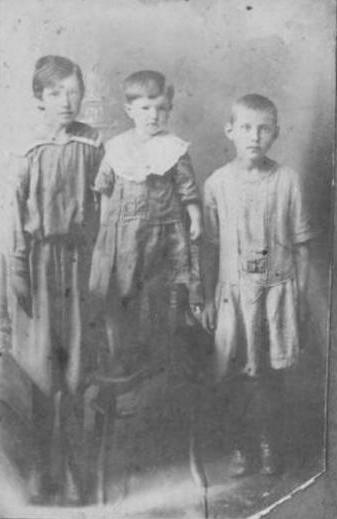
Russian Boys' Clothes: Chronology--20th Century

Figure 1.--The three children here are unidntified. The CDV looks to have been taken in the 1910s or perhaps early-20s. This was terrible time in Russia, World War, the Rebolution, and Civil War. The clothes are difficult to date, but the mount suggests the 1910s. During Tsarist times most of the photographic portraits during the Tsarist era were of the the upper class or comfortable middlle-class wearing dashionable clothes. Conditions deteriorated after the onset of World War I. The dealer here notes, "I have found this photo at the loft of old house in an old Russian town. It is in the Ural mountains along the River Ural. It was founded in 1736 and was a trading crossroads between Asia and Europe. Many of the residents are descendents of cossacks."
|
|
Generally we prefere to assess chronological trends by decades, but the Bolshevik Revolution (1919) was such a watermark event that we think it is appropriate to divide Russia's 20th century chronology by the Tasarist (1900-19), Soviet (1919-91), and post-Soviet 1992-2000) eras. There were major fashion shifts in part ideological and in part economic. Russian srtles at the begining of the 20th century were sharply divided. The upper class and urban middle class sported the fashionable clothing of the West. The working class, especially the rural population dressed very differently, boys commonly wore tunics which for some reasonnsparked a popular Western style--the Russian blouse. This changed with the Revolution. Fashion was no longer ideologically acceptable. Thus we see much less fashionable clothing in the cities, but in rural areas the peasant clothing rapidly declined and children ransitioned to Western styles, although not very fashionnle western clothing. You no longer see advertisemnts in magazines and newspapers. A Soviet propaganda wildly overstated the income gains of the woring class. And income leves lagged far behind the west, affecting how people dressed. But even the Iron curtain could not keep fashion out, especially after Stalin died and the NKVD/KGB had to moderate its fierce repressive regime to some extent. Russian teenagers all wanted blue jeans and oher western styles. As a result, by the time the Soviet Union emploded, Russian children had already adopted the popular pan-European styles of the West. The most obvious difference between Russian and Western clothing was the persistance of long stockings in the post-World War II era and then the transition to tights.
Little boys continued to wear dresses after the turn of the Century, but this fashion was passing and for the most part relatively young boys wore dresses. Sailor suits were popular for boys. The
Czarevitch Alexis almost always wore sailor suits, until World War I began (1914). Then he mostly wore army uniforms. Many other arristocratic and wealthy boys, as well as
middle class boys, also wore sailor suits, but this was a realtively small part of the population. The sailor suit was probably a reflection of the German influence. More common for most Russian boys were loose fitting Russian blouses with closed collars. This style also became popular in Germany and other European countries, but there the open square collared Russian blouse was more common. School age boys sometimes had their hair shaved as in Germany. Many boys went barefoot.
Even before the Russian Revolution, Russia except for the elite was a
basically closed society. Fashionable clothes were not generally available to Soviet
citizens and restrictions on foreign publications and travel restricted
the spread of European fashion trends. After knee pants had passed out of style in the 1910s, Soviet boys mostly wore long pants. Knickers were never popular in the Soviet Union. Boys did wear shorts, but mostly during the summer. Russian boys like boys in Scandinavia, Poland, and Germany continued to wear long stockings after knee `socks had become more common in Europe. Boys wearing short pants might wear them with long stockings. After tights becamev availabe in the 1950s, younger boys wore them with short pants during the winter. Sailor suits did not disappear after the Revolutionm. Andrea Sakarov, the noted physicist and disident, for example wore a sailor suit as a boy. I am not sure, however, how common that was.
Russian boys, since the end of the Soviet Union in 1991, have begun increasingly to dress like boys in the rest of Western Europe. We do not know much about boys' styles in modern Russia. From the limited information we have, Russian boys seem to dress similarly to Wesern boys, but we note some differences. Tights seem to be commonly worn by younger boys. Also we seem to note that Russian boys are more likely to dress up and wear suits for special occassions. Casual clothing seems very vsilimar to Wesrern styles. we do not note, however, the long below the knee shorts that became popular in the West after the late 1990s. Our information, however is to limited for any valid assessments at this time.
HBC

Navigate the Boys' Historical Clothing Web Site:
[Return to the Main Russian chronology page]
[Introduction]
[Activities]
[Biographies]
[Chronology]
[Clothing styles]
[Countries]
[Girls]
[Topics]
[Bibliographies]
[Contributions]
[FAQs]
[Glossaries]
[Images]
[Links]
[Registration]
[Tools]
[Boys' Clothing Home]
Navigate the Historic Boys' Clothing Russian pages:
[Ballet]
[Children's literature]
[Choirs]
[Fashion magazines]
[Movies]
[Royalty]
[School uniform]
[Youth groups]
Navigate the Boys' Historical Clothing Web Site:
[Return to the Main Russian page]
[Return to theMain country page]
[Australia]
[Canada]
[England]
[France]
[Germany]
[Ireland]
[Italy]
[Mexico]
[New Zealand]
[Poland]
[Scotland]
[United States]
Created: 2:34 AM 7/5/2019
Last updated: 2:34 AM 7/5/2019



